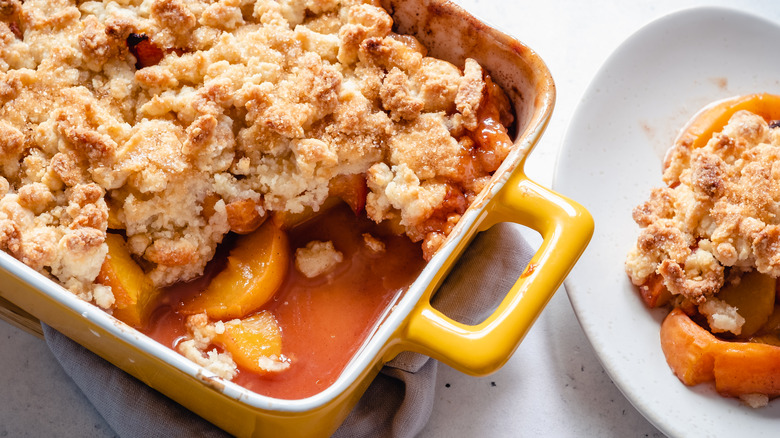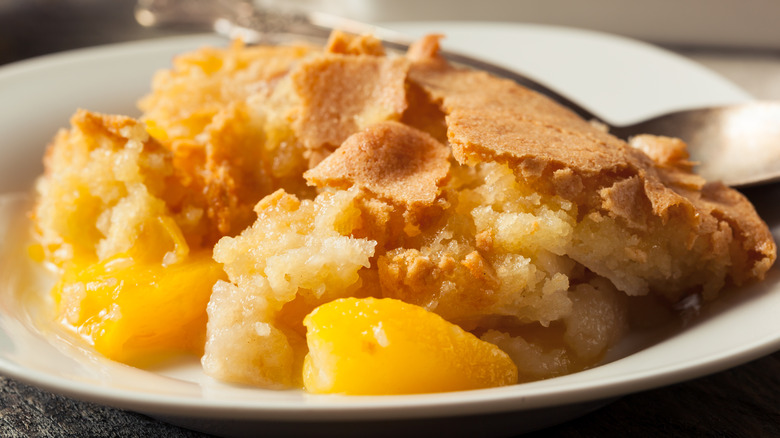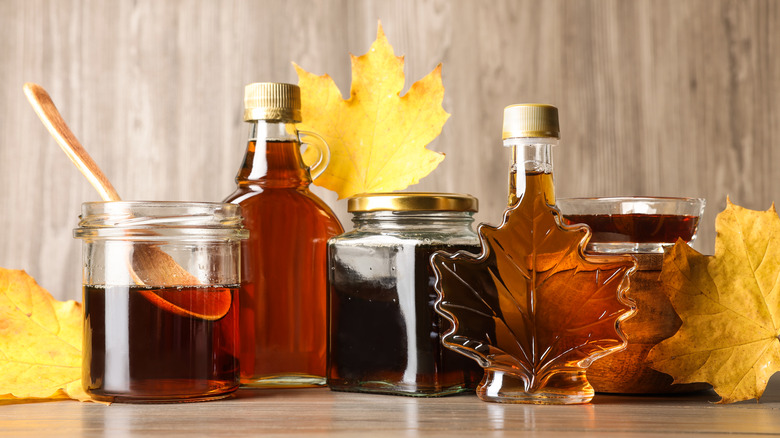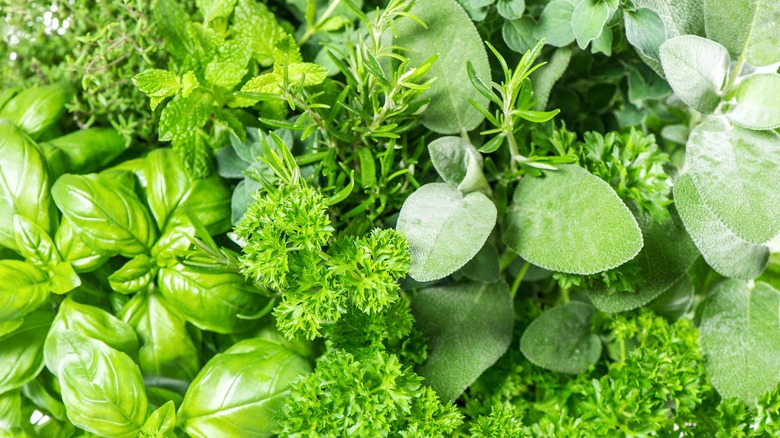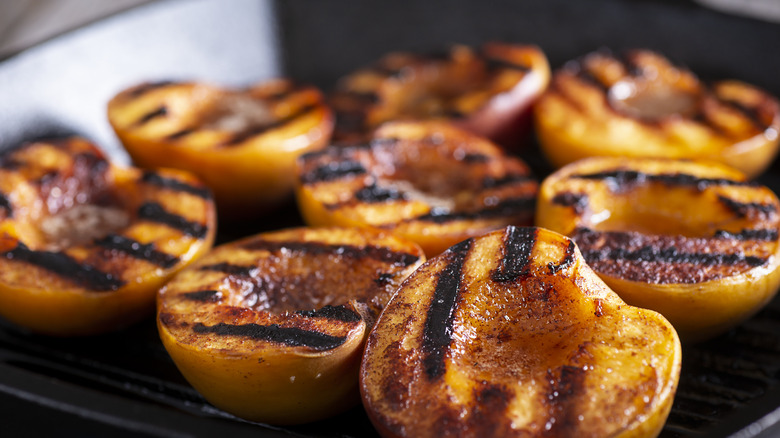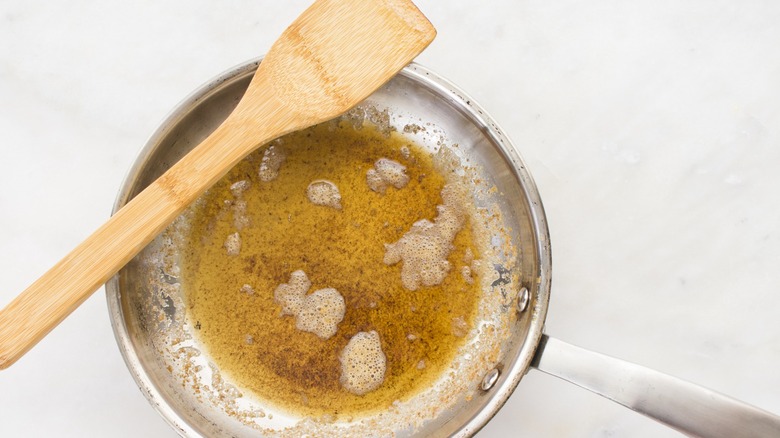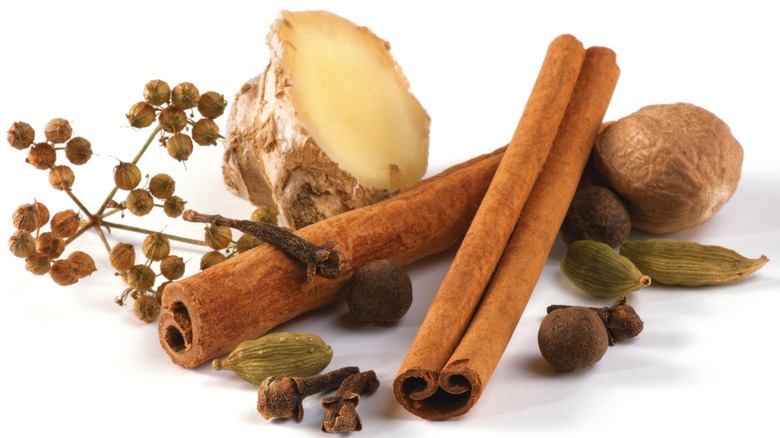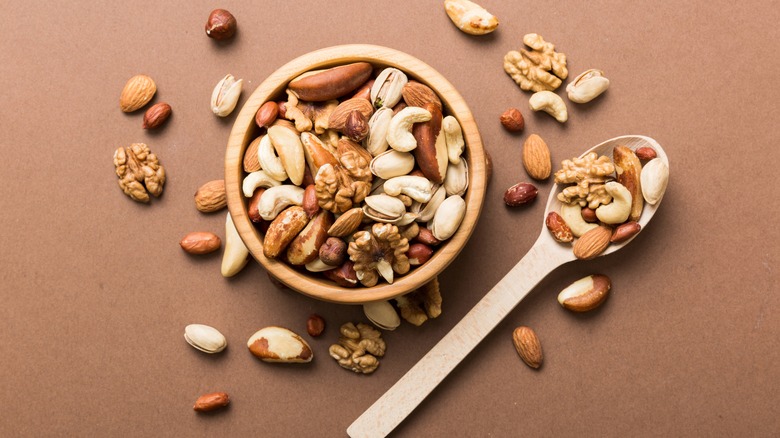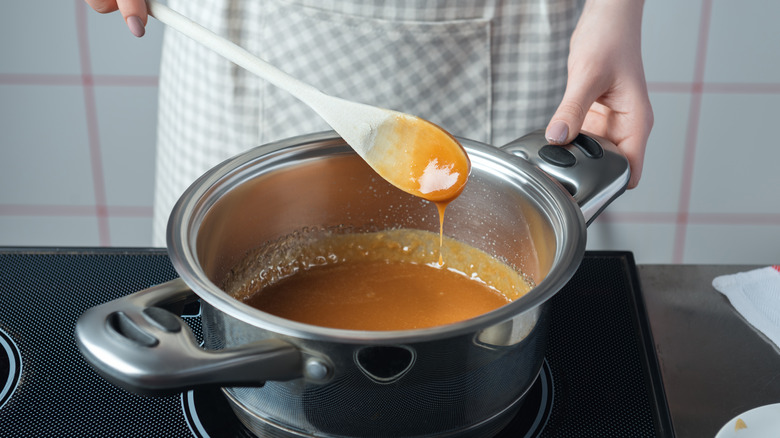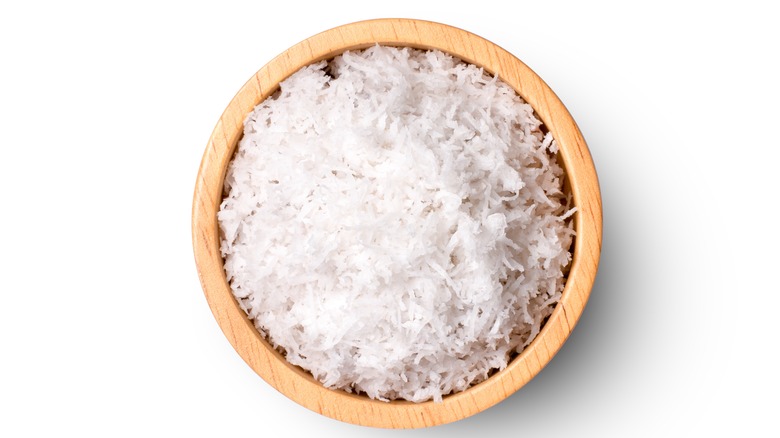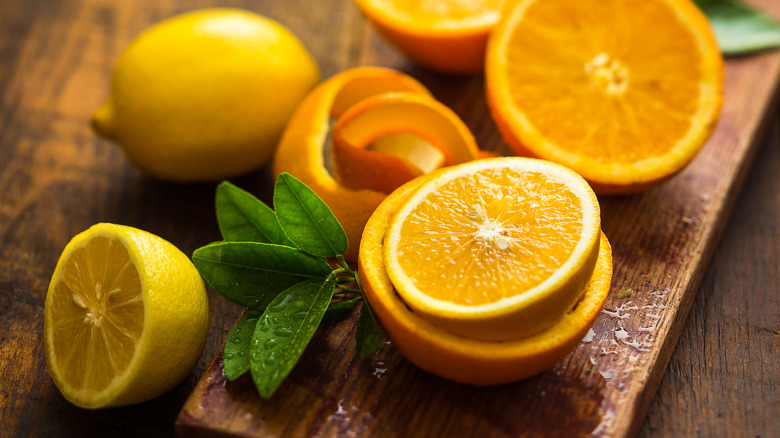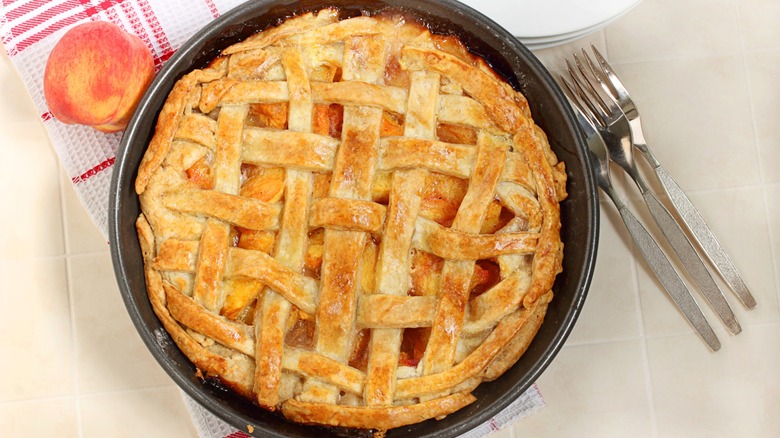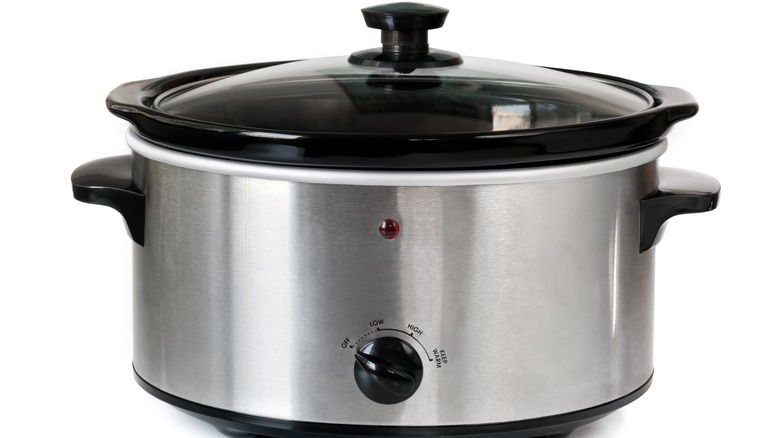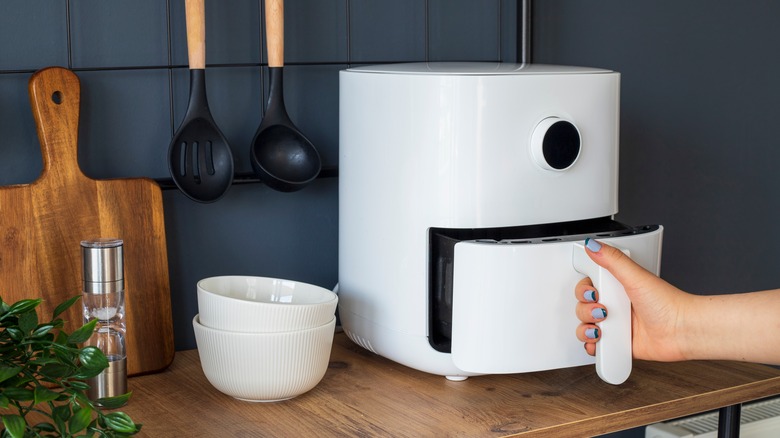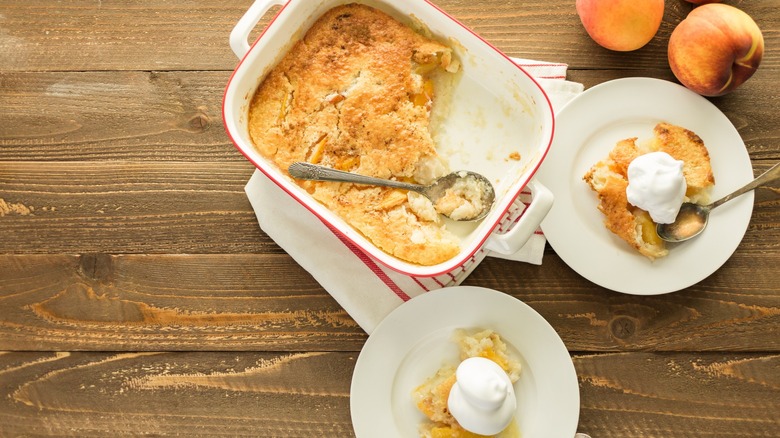Baker Reveals The Best Ways To Upgrade An Old-Fashioned Peach Cobbler
Peach cobbler is a well-known and comforting dessert many grew up eating. The basic recipe involves loading peach filling into a baking dish with dough on top and baking it until the surface is golden brown and the fruit filling is syrupy and bubbly. The dessert typically has a rustic look — which is part of its appeal. It doesn't have to look like it came out of a 5-star restaurant. So, even if you don't have advanced baking skills, making a scrumptious and special peach cobbler is still possible.
I firmly believe there's nothing wrong with making improvements to old-fashioned recipes. For example, you can add or swap certain ingredients, change the topping, or cook it in a different appliance besides the oven. As a pastry chef, I've created many delicious peach cobblers in my career. Some were traditional, while others were more innovative and personalized. If you want to give your old recipe a makeover or want your first-ever peach cobbler to be a hit, you can take inspiration from these ideas and tailor them to fit your vision.
1. Experiment with the topping
Peach cobbler can mean different things to different people, depending on the region you're from. The traditional version has a biscuit or scone-like dough on top of a layer of peaches. However, a sweeter, cake-like batter is also common. If you don't have time to make this topping yourself, you can always use store-bought products like Bisquick or cake mix to make the process easier.
There are plenty of ways to upgrade the topping. One delicious technique is to make a sweet batter and sprinkle it with cinnamon streusel. This way, you have more of a cake-like surface and get some crunch. This would be a fusion of a cobbler and a crisp. You can also add mix-ins to your biscuit dough, such as dried or fresh blueberries, which might remind you of blueberry scones on top of the peaches. If you want to try something even more unique, use crescent dough, puff pastry, or pie crust. These give the dessert a crispy, delicate, and delicious look and texture.
2. Add a touch of maple or honey
If you want to enhance the sweetness in a peach cobbler filling, use honey or maple syrup. This simple swap makes a big difference in how the dessert tastes. These ingredients have a deeper flavor than plain granulated sugar, so they highlight specific flavor notes in the peaches that sugar doesn't. Maple has a warm caramel-like undertone, while honey can be floral, fruity, or woody depending on the type. However, substituting the entire sugar amount with one of these options might leave you with an overpowering taste.
Instead, use 50% sugar and 50% natural liquid sweeteners. Or, if you want a more subtle flavor change, add just 1 to 2 tablespoons of maple or honey per batch. Regarding maple specifically, avoid using unhealthy store-bought pancake syrup. Instead, opt for 100% pure maple syrup. This provides a richer flavor without the artificial taste or unnecessary additives. By using the real deal, you can create the best-quality dessert possible.
3. Make it livelier with fresh herbs
Adding fresh herbs brings a light and refreshing balance to the typically comforting and heavy dessert of cobbler. Although many herbs pair well with peaches, I suggest rosemary, thyme, or basil. Each has special qualities that can add to the cobbler's flavor depth. Basil is soft and sweet, rosemary is fragrant and woody, and thyme is earthy. If you use basil, produce a chiffonade by rolling the leaves and cutting them into thin strands. For thyme or rosemary, chop the leaves finely to avoid large pieces in the dessert. For one pan of cobbler, you only need about 2 to 4 tablespoons of herbs in the filling. You can always start with the smaller amount, run a taste test, and determine if you'd like to add more.
The key to using these delicate ingredients is adding them at the right time. If you make your filling on the stovetop, don't mix them in immediately.; rather, wait until you remove the filling from the heat to add the herbs. This simple measure prevents the herbs from overcooking — after all, they will be baked in the oven, too. Reserve extra herbs for garnish to sprinkle on top when you plate the cobbler. The raw herbs will have a brighter color and add to the charm of the dessert.
4. Grill the peaches beforehand
For a sweet and smoky effect, go the extra mile and grill your peaches for the dessert. You can use an indoor grill pan if you don't have an outdoor appliance. Cutting the peaches in half for this technique is best — don't try to grill many small peach slices. Once you've cut all the fruit, use a pastry brush to apply neutral oil or melted butter to the inner flesh, preventing them from sticking. You can also sprinkle on some baking spices for added flavor.
Carefully place the peaches flat side down (not the side with skin) on the grill or pan. Then, allow them to cook for at least four minutes. Check on them by carefully lifting one side of the fruit. Examine the grill marks and see if the peaches are softened to your liking. Depending on your grill, you might need to let them cook for a few minutes longer. You can also flip and cook them on the skin side, but that's optional. Let the fruit halves cool slightly before cutting them into slices and tossing them with sugar, cornstarch, and other filling ingredients. Then, you can make the cobbler as usual.
5. Brown your butter
Brown butter can add complexity to all sorts of savory and sweet foods, and peach cobbler is no exception. This ingredient is exactly what it sounds like — it's simply regular old butter that you cook until it becomes brown and has a nutty flavor. If your recipe already involves butter, you can easily transform it into a brown butter peach cobbler by mixing brown butter into the topping or filling.
To brown the butter, cut the butter into cubes and place it in a heavy-duty pan over medium heat to melt it. Stir it constantly while observing it. Its color will darken, and you'll see specks (these are milk solids) start to form. Ideally, the entire mixture should be amber and have a toasty smell. You can remove the pan from the heat when you notice those qualities. Once it reaches this point, the butter can burn in the blink of an eye. Finally, transfer it to a heat-safe container and allow it to cool partially before using it in your recipe.
6. Add various spices
Many people use cinnamon in their peach cobbler, but interestingly enough, some recipes don't include it (or any other spices, for that matter). While cinnamon goes well with peaches, a good cobbler recipe should have a variety of spices to boost the flavor. Some excellent choices include nutmeg, cloves, ginger, and allspice. Another delicious creation is a cardamom peach cobbler, which utilizes the spice in the filling and cinnamon in the topping. This recipe only needs ¼ teaspoon of cardamom and ½ teaspoon of cinnamon for these spices' flavors to shine.
Generally, for every 6 cups of fruit, you only need 1 to 2 teaspoons of ground spices for a sufficient and pleasant flavor. You can use any combination you please, but remember that certain spices are more potent than others. For instance, you can go heavier on the cinnamon and nutmeg (which tend to be lighter), while going lighter on cloves and allspice (which tend to be more potent). When in doubt, start with less and work your way up after taste-testing.
7. Include nuts in the filling or topping
Nuts are another versatile cobbler ingredient; you can use them in the filling, the topping, or both. There's something quite delicious about walnuts, pecans, or almonds in a peach cobbler. Walnuts have an earthy taste with a pleasant bitterness. Almonds can be bitter, too, but they're also sweet. Pecans are more buttery in flavor than the other two. Whichever you decide to use, you can easily mix them into the filling, because you can eyeball how much you want to include. Using a specific nut-to-fruit ratio isn't necessary.
For the best results, rough chop the nuts before mixing them in. You can also toast them beforehand, which gives the cobbler a more sophisticated flavor. They will slightly soften in the filling. If you want your cobbler to have more of a crunch, use your nuts in the topping. This way, they are closer to the direct heat, and you can sprinkle them on them just before baking. I recommend using nuts in a peach cobbler with a cake-like topping, but any topping type works.
8. Make caramel for the filling base
Making a caramel peach cobbler is one of the best ways to transform the humble dessert. Believe it or not, you don't have to be a pro to make caramel sauce; you just have to keep a close eye on it to prevent it from burning. Cobbler doesn't require large amounts of caramel, but you need enough to thoroughly coat the peaches. A helpful guideline is to use ½ cup to 1 cup of sugar for every 4 cups of peaches. Add some water (about 25% of the amount of sugar you use). So, for 1 cup of sugar, you need ¼ cup of water.
In a thick-bottomed pan, add both ingredients and cook them over low heat for the sugar to dissolve. Use a pastry brush dipped in water to coat the pan's sides and prevent the sugar from crystallizing. Allow the caramel to cook until the mixture turns golden to amber in color. Remove it from the heat and add the same amount of cream as water. If you wish, you can also throw in a pinch of table salt and a couple of tablespoons of butter. Allow the caramel to cool slightly before you fold it with the peaches. Unfortunately, if you're impatient, you'll end up with sad, soggy fruit — so the wait is worth it. When it comes time, toss the fruit in the sauce, transfer it to a baking dish, and cover it with your desired topping.
9. Mix the peaches with coconut
Coconut can give an excellent textural contrast to your cobbler. The tender peaches and gooey filling surely benefit from its grittiness, plus, the coconut adds a unique flavor. For every 5 cups of sliced peaches, 1 cup of coconut will get the job done. You can use shredded coconut or coconut flakes. Ideally, use the sweetened kind. When working with the unsweetened stuff, I've found that it doesn't have as much moisture, so it can affect the filling by soaking up liquids and drying it out.
When using sweetened coconut, be mindful of the overall sweetness of the dessert. You don't want to accidentally overdo it. If you're worried about it, use less sugar in the filling or topping to compensate; the sweetness will balance it. And if you want to amp up the coconut flavor even more, consider using coconut milk or coconut extract in the biscuit dough.
10. Add citrus to the dish
Fresh citrus can have the same effect as fresh herbs; both add a refreshing touch. You've been missing out if you've never paired peaches with a citrusy ingredient. Specifically, the zesty flavors of lemon or orange are an incredible match for the sweet fruit. Additionally, they are easy to incorporate into your recipe. Even though you can use citrus extracts, I suggest using freshly squeezed citrus juice and zest, which gives an authentic taste.
If you're unsure how much to use, start with ¼ cup of fresh juice for every 1 pound of fruit. If your recipe calls for cooking the filling on the stovetop before baking, you can use the juice to dissolve the cornstarch. When adding zest to your recipe, it's crucial to use a zester or grater that can make very fine shreds with a pleasant texture. Also, you don't have to measure the zest, just extract as much as possible from the fruit you're already using.
11. Create a design on top
Depending on the type of topping you use, you might be able to create a unique design. This is easy to do if you use pie crust, puff pastry sheets, or crescent dough for the topping. You can cut the dough into strips to make a lattice top crust. To create this woven pattern, start by laying a few parallel strips. Then, fold back every other strip and place a perpendicular strip under them. Set the lifted pieces back down. Repeat this process, alternating which strips you fold back until you've completed the design.
Another idea is to use cookie cutters to cut out shapes like squares, hearts, or stars from your sheets of dough. Place the fruit filling into the dish and arrange the cut-out shapes in a design you like on top. This will make the cobbler stand out for its unique appearance once it bakes. For a shiny golden crust, brush it with egg wash before baking.
12. Slow cook it
Instead of baking the cobbler in the oven, you can make a slow cooker peach cobbler. By baking the dessert low and slow, the peaches become perfectly tender and the cobbler topping doesn't dry out. The moisture is contained within the lid — rather than exposed to a heating element in the oven — so it's great for people who prefer a soft topping over a crispy one.
It's also a set-it-and-forget recipe suitable for hosting parties. You can pop the cobbler in the slow cooker and prepare other foods. In the summer, a slow cooker doesn't heat the entire house as your oven would. Making the dessert this way is simple. Place the sliced fruit in the appliance, cover it with a mixture of flour, sugar, salt, and baking powder, and then place butter pieces on top and let the appliance do the rest of the work for you.
13. Bake it in the air fryer
If you're more of an air fryer person than a slow cooker one, the air fryer can be your best friend when it comes to making peach cobbler. An advantage is that it cooks it much faster than other appliances. Sometimes, the dessert can cook in as little as 10 minutes, but it can take up to 25 (depending on the recipe). The downside to this method? It makes fewer servings — unless you have a jumbo air fryer. When cooking cobbler in this appliance, it's best to assemble the dessert in ramekins, which you can serve individually.
Since the machine is so compact, it can cause the tops of the cobbler to burn when it approaches the end of cooking. If you check on them and they still need longer to cook but already have enough color, you can place foil over the ramekins to protect the surface while the center bakes longer. It also depends on what temperature you use. Stick to a moderate temperature, like 350 degrees Fahrenheit, to prevent over-browning.
14. Garnish it with something light and creamy
As you can see, there are numerous ways to make and enjoy peach cobbler. Aside from the suggestions listed above, I also recommend serving it with a complementary garnish. It's already been established that peach cobbler is the quintessential comfort food; it's warm, satisfying, and can even feel substantial for a dessert. Therefore, to balance out the heaviness, it needs something creamy. When you serve it, consider pairing it with classic whipped cream. You can also make whipped mascarpone, which has less sweetness but still provides lightness. Either of these toppings are quick to whip up.
However, you can also opt for something pre-made, like a frozen whipped topping or store-bought ice cream. Don't be afraid to experiment with different flavors and combinations. Although it seems standard, vanilla is not the only option. You can try cinnamon or caramel ice cream. Even a creamy yet bittersweet dark chocolate ice cream can work.
